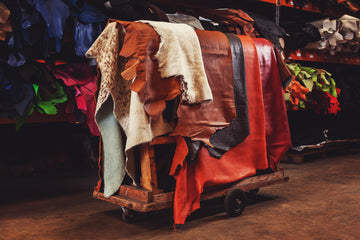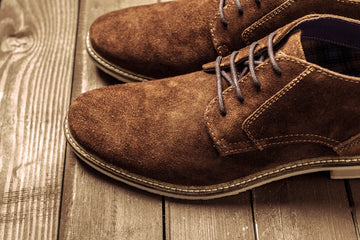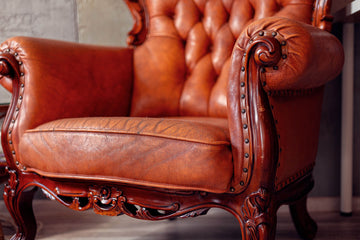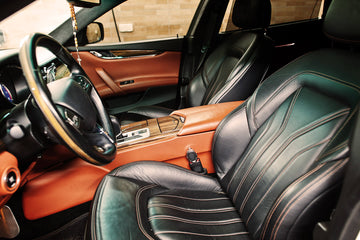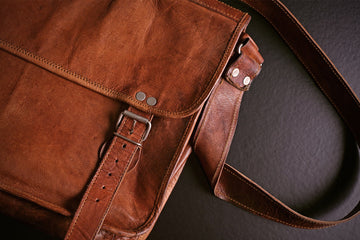Standing in a store faced with two similar-looking leather items, you might wonder what sets nubuck apart from suede. Both materials share that distinctive velvety texture and soft appearance, yet one costs significantly more than the other. The confusion is understandable—these leathers look remarkably similar at first glance.
The real difference between nubuck and suede leather lies in their origin within the animal's hide and how this fundamental distinction affects everything from durability to price. Understanding these differences will help you make informed decisions whether you're shopping for shoes, accessories, or furniture.
In this comprehensive guide, we'll explore exactly what makes nubuck and suede unique, compare their practical characteristics, and help you determine which material best suits your needs and lifestyle.
The Key Difference Explained
The fundamental difference between nubuck and suede leather comes down to which part of the animal's hide each material uses. Nubuck is crafted from the outer layer (grain side) of the leather hide, which is the top layer of the animal's hide and is the most durable and dense part. Suede, on the other hand, comes from the inner surface of split leather layers.
This distinction might seem technical, but it creates profound differences in performance. When leather producers make nubuck, they start with full-grain leather—the strongest part of the animal's skin—and lightly sand the visible surface of the outer layer to create that characteristic velvety finish. The grain structure remains intact beneath the napped texture, preserving much of the leather's natural strength.
Suede takes a different approach entirely. Leather makers split the animal's hide into layers through a leather cut, then work with the inner surface (flesh side) to create the soft, fuzzy texture. This process uses the pliable lower layers of the animal's skin, which naturally have a looser fibre structure than the protective grain side.
The result? Nubuck retains the durability advantages of top-grain leather, while suede prioritises softness and flexibility. This core difference ripples through every aspect of how these materials perform, from their water resistance to their lifespan.
What is Nubuck Leather
Nubuck represents a premium approach to creating velvety textured leather. Made from the top-grain leather of animal skin—typically calfskin or cowhide—nubuck undergoes chrome or vegetable tanning followed by careful sanding of the grain surface. While both nubuck and typical leather originate from high-quality hides, nubuck is distinguished by its unique sanding process, which produces a soft, napped finish.
The manufacturing process begins with high-quality leather that would otherwise become smooth leather. Instead of applying a protective finish, leather workers lightly abrade the outer layer using fine-grit sandpaper or similar tools. This sanding process creates the signature napped finish while preserving the underlying grain structure that gives nubuck its strength.
The texture characteristics of nubuck leather set it apart from other leather types. You'll notice a fine, tight nap that feels substantial under your fingers. Unlike suede, nubuck shows natural grain patterns, pores, and even occasional scars from the animal's skin—marks that actually enhance its authentic character.
Nubuck's durability comes from retaining the full-grain leather structure. The tight fibre network that once protected the living animal remains largely intact, having only softened with the gentle sanding. This is why nubuck shoes and nubuck leather goods can withstand years of use while maintaining their appearance. There is a significant difference in texture and durability between nubuck and other types of leather due to its full-grain structure.
Historically, the term "nubuck" originates from "new buck," referring to the original buckskin leather made from deer hide. Today's nubuck primarily uses calfskin, which offers superior consistency and availability while delivering the same luxurious texture that made the original material so prized.
What is Suede Leather
Suede leather takes its name from the French phrase "gants de Suede," meaning "gloves from Sweden," where skilled craftsmen first perfected this delicate material in the 19th century. The manufacturing process begins by splitting the animal's hide into multiple layers, then working exclusively with the inner flesh side to create that distinctive fuzzy texture.
The process starts with the inner layer being separated from the top grain through mechanical splitting. Leather workers then sand this inner surface to create the soft, raised fibres that give suede its characteristic feel. Both suede and nubuck are valued for their similarly velvety feel, though suede tends to have a softer, smoother feel. Unlike nubuck, which preserves the grain structure, suede's appeal lies in its uniform, plush appearance.
Suede's texture characteristics differ significantly from those of nubuck. The nap feels fluffier and softer, with longer fibres that create a more pronounced fuzzy texture and a smooth feel compared to other leathers. When you run your hand across quality suede, the surface appears uniform without the natural grain markings visible in nubuck.
Common sources for suede include lambskin, goatskin, pigskin, and cowhide splits. Lambskin produces the softest, most delicate suede, while goatskin offers slightly more durability. Cowhide splits—the leftover layers after top grain removal—provide the most economical suede options.
The lightweight texture of suede makes it ideal for fashion accessories and clothing applications where drape and flexibility matter more than raw durability. This is why you'll find suede prominently featured in luxury handbags, gloves, and clothing items where the material's soft feel enhances the wearing experience.
Leather Hides: The Source of Nubuck and Suede
Every piece of nubuck and suede leather begins its journey as a high-quality leather hide, most often sourced from cowhide, calfskin, or sheepskin. The selection of the leather hide is crucial, as it determines not only the durability and appearance of the final product but also the signature feel that sets these two leathers apart.
The key distinction between nubuck and suede begins with the part of the hide used. Nubuck leather is crafted from the outer layer—the grain side—of the animal's skin. This outer layer is naturally tougher and more resilient, making nubuck shoes and leather goods robust enough for everyday wear. After tanning, the surface is gently sanded to create that sought-after velvety texture, while still preserving the strength and character of full-grain leather.
Suede leather, on the other hand, is made from the inner surface of the hide. Once the top grain is split away, the softer, more pliable lower layers are sanded to produce suede's signature fuzzy texture. This inner layer gives suede shoes and accessories their lightweight, luxurious texture, but also makes them more delicate and requires extra care to maintain their appearance.
Because the outer layer used for nubuck is denser and more durable, nubuck leather stands up better to daily use and resists wear and tear more effectively than suede. Suede's inner layer construction, while softer and more flexible, is more prone to staining and water damage. That's why protecting suede and nubuck with water- and stain-repellent treatments is essential, especially if you plan to wear suede or nubuck shoes in unpredictable weather conditions.
When it comes to cleaning, suede requires a gentle touch—a soft-bristle brush is ideal for removing dust and maintaining the nap, while nubuck can be refreshed with a dry cloth or a soft brush. Both leathers should be kept away from direct sunlight and excess dirt to preserve their colour and texture.
Understanding the source and processing of the leather hide helps explain why nubuck and suede each have their own unique appeal. Whether you're drawn to the robust, velvety finish of nubuck or the soft, fuzzy feel of suede, both leathers offer a touch of luxury to shoes, fashion accessories, and other leather goods. By choosing the right care routine and protective products, you can enjoy the beauty and comfort of these two leathers for years to come.
Detailed Comparison: Nubuck vs Suede
Texture and Feel Differences
The most immediately noticeable difference between these two leathers lies in their tactile experience. Nubuck features a finer, tighter nap that feels firmer and more structured when touched. The surface maintains enough body to resist easy compression, giving it a substantial feel that speaks to its underlying strength.
Suede offers a distinctly different experience with its fluffier, softer nap. The longer fibres create a plush, velvety touch that yields readily to pressure. This luxurious texture makes suede particularly appealing for fashion applications where comfort and sensory appeal take priority.
Visual differences become apparent under close examination. Nubuck retains natural grain markings—the pores, wrinkles, and occasional scars that mark the leather's authentic origins. These imperfections, far from being flaws, demonstrate the material's genuine leather heritage and add character to finished products.
Suede presents a more uniform appearance. The split leather construction and sanding process produce a consistent surface texture, eliminating the natural variations typically found in grain leather. This uniformity makes suede ideal for applications requiring a smooth, even appearance.
Thickness comparisons reveal another practical difference. Nubuck typically measures 1.2-1.6mm thick, while suede ranges from 0.6 to 1.2mm. This thickness advantage contributes to nubuck's superior durability and helps explain why nubuck leather goods command higher prices.
Durability and Strength
The durability gap between nubuck and suede stems directly from their construction differences. Nubuck's grain structure provides superior fibre density and natural elasticity, characteristics evolved to protect living animals from environmental stresses. When transformed into leather, these same properties deliver exceptional abrasion resistance and tear strength.
Suede's split-layer construction inherently lacks this robust foundation. The pliable lower layers simply don't possess the tight fibre network found in grain leather. While this makes suede wonderfully soft and flexible, it also means the material shows wear patterns more quickly and proves more susceptible to damage.
Real-world longevity reflects these structural differences dramatically. Well-maintained nubuck products typically last 3-5 years with regular use, while comparable suede items generally show significant wear within 1-3 years. This longevity advantage makes nubuck an attractive choice for items like shoes and bags that are subjected to daily use.
Wear patterns tell different stories for each material. Nubuck develops character over time, with high-contact areas taking on a slightly smoother appearance while retaining structural integrity. Suede tends to show wear more dramatically, with high-friction zones becoming thin or developing holes.
The strength advantage becomes particularly important for applications involving stress or repeated flexing. Nubuck shoes maintain their shape and support even after thousands of steps, whereas suede shoes may develop structural weaknesses that impact both appearance and comfort.
Water Resistance
Water resistance represents one of the most practical differences between these materials. Nubuck's denser grain structure naturally resists moisture penetration better than suede's open fibre construction. While neither material qualifies as naturally waterproof, nubuck provides a meaningful advantage in damp conditions.
Suede's highly porous structure makes it extremely vulnerable to water damage. The split leather construction creates numerous pathways for moisture to penetrate deep into the material. Once wet, suede often develops permanent stains, changes colour, or becomes stiff and brittle.
The grain structure of nubuck offers some natural protection, though it still requires care in wet conditions. The tighter fibre network slows water penetration, giving you time to address spills before they cause permanent damage. However, untreated nubuck will still absorb moisture and can develop water stains.
Both materials benefit significantly from protective treatments. Water and stain repellents should be applied every 3-6 months for items in regular use. These treatments work by creating a molecular barrier that helps liquids bead up and roll off rather than penetrating the leather fibres. Waxed suede is another option for enhancing water resistance, as the waxing process helps repel moisture and makes the normally porous suede less absorbent.
When drying wet nubuck or suede, both require air drying away from direct heat sources. Hair dryers, radiators, and direct sunlight can damage the delicate nap of the finish and cause the leather to crack or become brittle. Patient air drying preserves both texture and integrity.
Cost Comparison
The price differential between nubuck and suede reflects their fundamental material differences. Nubuck generally costs 20-40% more than comparable suede products, a premium that stems from both the raw material costs and the complexity of manufacturing.
Nubuck's higher cost starts with the need for premium-grade hides. Since nubuck exposes the grain surface, any significant flaws in the original hide become visible in the finished product. This requirement for high-quality raw materials naturally drives up production costs.
Suede production can utilise lower-grade hides and split layers that might otherwise become waste products. This efficient use of materials helps keep suede prices more accessible while still delivering the desired aesthetic and tactile qualities.
Value considerations extend beyond initial purchase price to include cost-per-wear calculations. A pair of nubuck boots costing £180 that last four years provides better value than £60 suede boots that require replacement after two years. The durability advantage often justifies the higher upfront cost of nubuck.
Brand positioning also influences pricing strategies. Premium brands like Timberland and Dr Martens frequently use nubuck for their flagship products, positioning it as the superior material choice. Fashion brands may price suede items higher based on style and design rather than material durability.
Best Uses and Applications
Ideal Nubuck Applications
Nubuck leather excels in applications where durability meets aesthetics. The robust fabric qualities inherited from full-grain leather make it the preferred choice for items that must withstand regular use while maintaining their appearance.
Heavy-duty footwear represents the strongest application of nubuck. Work boots, hiking boots, and casual sneakers greatly benefit from nubuck's exceptional abrasion resistance and water-resistant properties. The material can handle rough surfaces, occasional moisture, and daily wear while developing an attractive patina over time.
Leather goods requiring structural integrity favour nubuck over softer alternatives. Wallets, handbags, and belts made from nubuck leather maintain their shape and function through years of use. The material's resistance to stretching and tearing ensures that these accessories continue performing their intended functions.
Furniture applications showcase nubuck's versatility. Utility in interior design. Upholstery for high-traffic seating—such as sofas, office chairs, and restaurant booths—benefits from nubuck's durability while offering the sophisticated appearance that smooth leather might lack. The material stands up to regular use without showing wear as quickly as more delicate alternatives.
Popular brands have built reputations around nubuck's superior performance characteristics. Timberland's iconic wheat nubuck boots showcase the material's exceptional weather resistance and durability. Dr Martens incorporates nubuck into their heritage designs, while Clarks uses it for desert boots that balance durability with style.
Perfect Suede Uses
Suede leather shines in applications where softness, flexibility, and aesthetic appeal take precedence over maximum durability. The delicate texture and luxurious feel make it ideal for items where comfort and style matter most.
Fashion footwear represents suede's primary strength. Dress shoes, loafers, and women's heels benefit from suede's elegant appearance and comfortable feel. The material's ability to drape and conform makes it especially suitable for footwear that demands a refined, sophisticated appearance.
Clothing applications leverage suede's lightweight texture and draping qualities: jackets, gloves, and fashion accessories made from suede offer unmatched softness and visual appeal. The material's flexibility allows designers to create flowing silhouettes impossible with stiffer leather types.
Interior applications focus on decorative rather than functional roles. Decorative pillows, accent furniture pieces, and low-wear upholstery can showcase suede's aesthetic appeal without exposing it to the heavy use that might cause premature wear.
Luxury fashion brands have elevated suede to iconic status in their collections. Gucci incorporates suede into handbags and shoes that emphasise elegance over utility. Prada uses the material for accessories where the tactile experience enhances the luxury positioning. Saint Laurent features suede prominently in collections that prioritise style and sensual appeal.
The fashion accessories market particularly values the unique combination of softness and visual interest that suede offers. Unlike traditional leather, suede's matte finish provides designers with a canvas for rich colours and textures that complement rather than compete with other design elements.
Care and Maintenance Guide
Nubuck Leather Care
Proper care extends the impressive natural durability of nubuck while preserving its characteristic appearance. The key lies in regular maintenance that prevents problems rather than correcting damage after it occurs.
Essential tools for nubuck care include a specialised nubuck brush—typically featuring brass or rubber bristles—along with nubuck-specific cleaners and waterproofing sprays. These tools work together to maintain the material's napped texture while protecting against stains and moisture.
Regular maintenance begins with weekly brushing using a gentle circular motion. This technique lifts the nap, removes surface dirt, and prevents the fibres from becoming matted down. The brass bristles effectively restore the texture without damaging the underlying leather structure.
Stain removal requires prompt attention and the use of appropriate techniques. For dry stains, a nubuck eraser can often remove marks without damaging the surface. Wet stains need immediate blotting—never rubbing—followed by application of specialised nubuck cleaners designed to lift stains without saturating the leather.
Protection scheduling prevents most problems before they develop. Apply waterproofing spray every 3-4 months for items in regular use, ensuring even coverage while maintaining the leather's breathability. This proactive approach significantly extends the life of nubuck products while preserving their appearance.
Storage considerations include keeping nubuck items in breathable containers and storing them away from direct sunlight. The material needs air circulation to prevent moisture buildup while avoiding exposure to UV rays that can fade colours and dry out the leather fibres.
Suede Leather Care
Suede requires more frequent and gentle care than nubuck due to its delicate structure and higher susceptibility to damage. Success depends on understanding the material's limitations and working within them rather than against them.
Required supplies include a soft-bristle brush specifically designed for suede, suede erasers for stain removal, and protective sprays formulated for the material's unique properties. Unlike nubuck tools, suede care implements emphasise gentleness over aggressive cleaning action.
Daily care routines make the difference between suede that maintains its appearance and items that quickly deteriorate. Brush gently after each wear to prevent dirt from embedding in the fibres and to keep the nap's direction. This simple step prevents most long-term problems.
Emergency care protocols promptly deal with spills and stains. Blot liquids with a dry cloth, avoiding excessive rubbing or pressing. Never saturate suede with water or cleaning solutions, as this can cause permanent damage to the split leather structure. If suede becomes damp after cleaning, you can use a hair dryer on the lowest setting to help dry the material, but use caution to avoid overheating or damaging the suede.
Professional cleaning is necessary for valuable suede items that have been exposed to significant soiling or staining. Annual professional treatment can restore colour and texture while addressing problems beyond the capabilities of home care. The investment often proves worthwhile for expensive or sentimental pieces.
Prevention strategies include rotating suede items to allow recovery between uses and storing them properly with cedar blocks or similar moisture-absorbing materials. Unlike traditional leather goods, suede benefits from gentler environmental conditions and less intensive use patterns.
How Can You Tell Nubuck from Suede by Touch?
The touch test provides the most reliable method for distinguishing between these materials. Nubuck feels firmer, with a fine nap that resists compression. When you press the surface, it springs back readily and maintains its texture.
Suede offers a distinctly softer experience. The fluffier nap compresses easily under light pressure and feels more flexible overall. The longer fibres create a sensation similar to that of velvet or fine fabric, rather than leather.
Visual inspection supports the touch test. Look for natural grain patterns, pores, or small imperfections that indicate nubuck's grain-side origin. Suede appears more uniform without these natural leather characteristics.
Thickness checking provides additional confirmation. Nubuck typically feels thicker and heavier than comparable suede items. This difference becomes particularly noticeable when comparing similar products, such as shoes or bags.
Price can serve as a final indicator. Nubuck items generally cost 20-40% more than comparable suede products, reflecting the material quality difference and manufacturing complexity.
Which Leather Type Is Better for Shoes?
The choice between nubuck shoes and suede shoes primarily depends on the intended use and lifestyle factors. Nubuck advantages include superior durability for everyday wear, better performance in various weather conditions, and longer-term value despite higher initial cost.
Nubuck works exceptionally well for active lifestyles and outdoor activities. The material's water resistance and abrasion resistance make it suitable for hiking boots, work shoes, and casual sneakers that face regular wear and tear.
Suede's advantages centre on comfort and style for specific applications. The softer material feels more comfortable for extended wear in formal settings, offers lighter weight for travel, and provides the refined appearance that certain fashion contexts require.
Climate considerations play a crucial role in selecting materials. Nubuck performs better in wet or humid conditions, where moisture resistance is vital. Suede excels in dry climates where its breathability and comfort take priority over weather protection.
Lifestyle matching determines the optimal choice. Active users who prioritise durability and weather resistance typically prefer nubuck. Fashion-conscious consumers who value style and comfort often gravitate toward suede for appropriate occasions.
Do Nubuck and Suede Stretch Over Time?
Stretching behaviour differs significantly between these materials due to their structural differences. Nubuck stretching remains minimal because the grain structure maintains its integrity even after the sanding process. The tight fibre network resists permanent deformation under normal use.
Suede stretching occurs more readily due to the split leather's naturally looser fibre structure. Footwear made from suede can stretch up to half a size with regular wear, which sometimes creates fitting issues if the original sizing was too snug.
Breaking-in periods reflect these stretching characteristics. Nubuck shoes require 2-3 weeks to conform to your feet while maintaining their essential structure. The process involves gradual softening rather than significant shape changes.
Suede adapts much more quickly, often conforming to foot shape within days of regular wear. This rapid adaptation can be beneficial for comfort but may lead to loose-fitting if the initial size was borderline.
Fit recommendations account for these differences. Buy nubuck shoes in your true size, as minimal stretching means the initial fit largely determines long-term comfort. Suede shoes can be purchased slightly snug, knowing the material will stretch and conform over time.
Conclusion
Understanding the real difference between nubuck and suede leather empowers you to make informed decisions about your leather purchases. While both materials share that appealing velvety texture, their distinct origins—grain side versus split layers—create meaningful differences in durability, care requirements, and appropriate applications.
Nubuck's grain-side construction provides superior durability and water resistance, making it ideal for everyday items such as shoes, bags, and furniture that must withstand regular use. The higher upfront cost often proves worthwhile through extended lifespan and maintained appearance.
Suede excels in applications where softness, style, and comfort take priority over maximum durability. Fashion accessories, dress shoes, and decorative items benefit from the luxurious feel and elegant appearance of suede, even if they require more careful handling and regular maintenance.
Whether you choose the robust durability of nubuck leather or the refined elegance of suede leather, proper care and realistic expectations about each material's capabilities will ensure satisfaction with your investment.
Why Buy Leather From Us?
At Rolford Leather, we take pride in being the leading supplier of leather in the UK. We offer expert knowledge about speciality leathers, including nubuck and suede. Our carefully curated selection features premium nubuck, ideal for durable footwear and accessories, as well as luxurious suede, perfect for fashion items and decorative applications.
🔗 Explore our nubuck collection
How to Buy Nubuck and Suede Online?
Are you ready to purchase nubuck or suede for your next project? Whether you're crafting durable nubuck shoes, creating elegant suede accessories, or choosing upholstery materials, our collection provides authentic options at various price points. Browse with confidence, utilising our detailed specifications and care instructions for each leather type.
🔗 Explore our suede collection
Stop wasting money on the wrong leather choice! Our leather experts are ready to help you avoid costly mistakes and find the perfect material for your project. Don't risk disappointment with inferior materials—let our specialists match you with premium nubuck or luxurious suede that will exceed your expectations.
Contact us now for your free consultation and discover why thousands of customers trust us for their leather needs.
